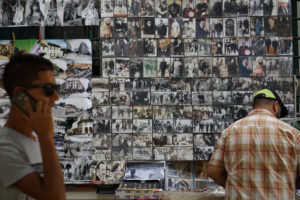Prix AWARE
© Photo: Louiza Ammi

Katia Kameli, Exhibition view Elle a allumé le vif du passé, Frac PACA @ Photo: Laurent Lecat

Katia Kameli, Stream of stories Chapter 2, installation, 2017, MACVAL museum.
From a childhood and adolescence spent between France, where her mother lived, and Algeria, where she joined her father, Katia Kameli has kept the sensation of always feeling like she belonged to two worlds at the same time. In Algeria, her double nationality allowed her access to both female-only and male-only circles, so she could report back what had happened to her female cousins. At this time, she seems to have developed the ability to remove the mystique surrounding the stories that populate shadowy margins. Throughout the last twenty years, she has thus explored her relationship with origins and knowledge through an artistic practice which brings together film, installation, and performance, enriched by photographs, sounds, theatre and drawings.

Image Still from The Algerian Novel – Chapter 1, 2016, HD Video, 16” 35’. © Katia Kameli, ADAGP

Image Still from The Algerian Novel – Chapter 1, 2016, HD Video, 16” 35’. © Katia Kameli, ADAGP
Katia Kameli’s work endeavours to examine the conditions in which history is written. To this end, the construction of a national Algerian novel is of particular importance in her work, such as in the video Bledi, un scénario possible (2004) – which she refers to as “the piece which has never let me go” – the video triptych Le Roman algérien (2016-2019), the photographic series Mon manuel d’histoire (2018), or Trou de mémoire (2018). For this last, a photographic installation about an Algerian public monument, Katia Kameli brought together visual archives which highlight the gaps in history, presenting them in the form of concertinaed images. In 2012, this monument cracked: in its fissures we see the Grand Pavois of Paul Landowski begin to appear, the war monument honouring Algerians who died in the First World War, which was covered up in 1978 by the sculptor M’hamed Issiakhem to make the old monument disappear without being destroyed, and to transform it into a monument for the heroes of the independence movement. This new story of glory and emancipation held inside itself that of the colonial past.
Katia Kameli methodically treats such instances of the return of that which has been repressed, reassembling the threads of the past to better understand what stories do to history. In Stream of Stories (2015-2022), she retraces the little-known origins of the text of Jean de La Fontaine’s Fables, which stem from the 3rd century Pañchatantra and the 13th century Kalila wa Dimna, as well as the subtle semantic changes which crept in unnoticed from one translation to the next. In these Specula principum in fabulary form, the famous adage of Traduttore, traditore doubles as a reminder of the political function of literary appropriation: making sure the origins are forgotten is to win the battle of anteriority, of power and legitimacy. It is likely for this reason that pedagogy and transmission have held a particular place in the artist’s career since the beginning. In 2006, and again in 2011, she organised the workshops “Bledi in Progress” and “Trans-Maghreb” in Algiers, aimed at young directors from Algeria, Morocco, and Tunisia, in order to give them the means to produce images and tell the (his)story of their country, about which they saw and heard appropriated stories thrive.
Katia Kameli’s projects never see the light of day without collaboration and cocreation. Her inclination towards working collectively – which, she highlights, comes from her filmmaking practice – reappears in every one of her works. Not only is each of Katia Kameli’s creations experienced by many, but they are also experienced at a crossroads of practices, of different intellectual and disciplinary fields. The authors invited in 2007 to write the texts of 7 Acts of Love in 7 Days in Boredom (2012); the militant Wassyla Tamzali; the photographer Louiza Ammi and the philosopher Marie-José Mondzain, called upon in Le Roman algérien to testify about their expériences of the Algerian civil war as well as independence and the black years; the author Chloé Delaume, who composed a fable about fables for the artist’s exhibition at FRAC Provence-Alpes-Côte d’Azur (2021): these are only some of the figures who lend Katia Kameli’s work its singularity.
Camille Richert
Katia Kameli was born in 1973 in Clermont-Ferrand. She lives and works in Paris. She was trained at the École nationale supérieure d’art in Bourges, in the Viennese studio of Michelangelo Pistoletto and at the Cittadellarte in Bielle, as well as at the Collège invisible, a one-year post-masters degree from the École supérieure des Beaux-Arts in Marseilles. She has participated in numerous international events, including the Biennials of Bamako (2011), Dakar (2012 and 2018), Mannheim (2017) and Rabat (2019). After her first personal exhibition in partnership with Vidéochroniques in Marseille and Transpalette in Bourges (2012), her work was shown in New York at the Taymour Grahne Gallery (2014), at The Mosaic Rooms in London and at the Biennale de Rennes (2016), at the Kunsthalle in Münster (2019), at the Konstmuseum in Kalmar (2020) and at the FRAC Provence-Alpes-Côte d’Azur in Marseille (2021). Her work is in the public collections of the Musée national d’Art moderne – Centre Georges-Pompidou, of the Centre national des arts plastiques, of the Fonds d’art contemporain – Paris collections, and of the FRAC Grand Large – Hauts-de-France, Bretagne, Poitou-Charentes and Provence-Alpes-Côte d’Azur.
Translated from French by Eléonore Besse.
Tous droits réservés dans tous pays/All rights reserved for all countries.






